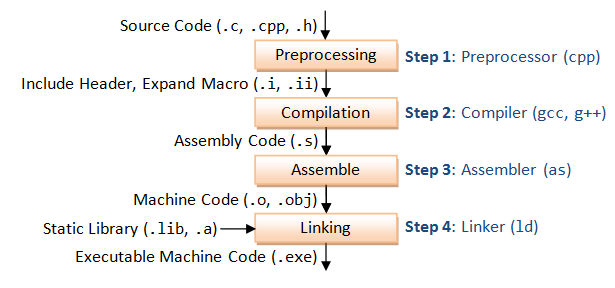原文:https://www.cnblogs.com/CarpenterLee/p/5994681.html
前言
C语言程序从源代码到二进制行程序都经历了那些过程?本文以Linux下C语言的编译过程为例,讲解C语言程序的编译过程。
编写hello world C程序:
// hello.c #include <stdio.h> int main(){ printf("hello world! "); }
编译过程只需:
$ gcc hello.c # 编译 $ ./a.out # 执行 hello world!
这个过程如此熟悉,以至于大家觉得编译事件很简单的事。事实真的如此吗?我们来细看一下C语言的编译过程到底是怎样的。
上述gcc命令其实依次执行了四步操作:1.预处理(Preprocessing), 2.编译(Compilation), 3.汇编(Assemble), 4.链接(Linking)。

示例
为了下面步骤讲解的方便,我们需要一个稍微复杂一点的例子。假设我们自己定义了一个头文件mymath.h,实现一些自己的数学函数,并把具体实现放在mymath.c当中。然后写一个test.c程序使用这些函数。程序目录结构如下:
├── test.c
└── inc
├── mymath.h
└── mymath.c
程序代码如下:
// test.c #include <stdio.h> #include "mymath.h"// 自定义头文件 int main(){ int a = 2; int b = 3; int sum = add(a, b); printf("a=%d, b=%d, a+b=%d ", a, b, sum); }
头文件定义:
// mymath.h #ifndef MYMATH_H #define MYMATH_H int add(int a, int b); int sum(int a, int b); #endif
头文件实现:
// mymath.c int add(int a, int b){ return a+b; } int sub(int a, int b){ return a-b; }
1.预处理(Preprocessing)
预处理用于将所有的#include头文件以及宏定义替换成其真正的内容,预处理之后得到的仍然是文本文件,但文件体积会大很多。gcc的预处理是预处理器cpp来完成的,你可以通过如下命令对test.c进行预处理:
gcc -E -I./inc test.c -o test.i
或者直接调用cpp命令
$ cpp test.c -I./inc -o test.i
上述命令中-E是让编译器在预处理之后就退出,不进行后续编译过程;-I指定头文件目录,这里指定的是我们自定义的头文件目录;-o指定输出文件名。
经过预处理之后代码体积会大很多:
| X | 文件名 | 文件大小 | 代码行数 |
|---|---|---|---|
| 预处理前 | test.c | 146B | 9 |
| 预处理后 | test.i | 17691B | 857 |
预处理之后的程序还是文本,可以用文本编辑器打开。
2.编译(Compilation)
这里的编译不是指程序从源文件到二进制程序的全部过程,而是指将经过预处理之后的程序转换成特定汇编代码(assembly code)的过程。编译的指定如下:
$ gcc -S -I./inc test.c -o test.s
上述命令中-S让编译器在编译之后停止,不进行后续过程。编译过程完成后,将生成程序的汇编代码test.s,这也是文本文件,内容如下:
// test.c汇编之后的结果test.s .file "test.c" .section .rodata .LC0: .string "a=%d, b=%d, a+b=%d " .text .globl main .type main, @function main: .LFB0: .cfi_startproc pushl %ebp .cfi_def_cfa_offset 8 .cfi_offset 5, -8 movl %esp, %ebp .cfi_def_cfa_register 5 andl $-16, %esp subl $32, %esp movl $2, 20(%esp) movl $3, 24(%esp) movl 24(%esp), %eax movl %eax, 4(%esp) movl 20(%esp), %eax movl %eax, (%esp) call add movl %eax, 28(%esp) movl 28(%esp), %eax movl %eax, 12(%esp) movl 24(%esp), %eax movl %eax, 8(%esp) movl 20(%esp), %eax movl %eax, 4(%esp) movl $.LC0, (%esp) call printf leave .cfi_restore 5 .cfi_def_cfa 4, 4 ret .cfi_endproc .LFE0: .size main, .-main .ident "GCC: (Ubuntu 4.8.2-19ubuntu1) 4.8.2" .section .note.GNU-stack,"",@progbits
请不要问我上述代码是什么意思!-_-
3.汇编(Assemble)
汇编过程将上一步的汇编代码转换成机器码(machine code),这一步产生的文件叫做目标文件,是二进制格式。gcc汇编过程通过as命令完成:
$ as test.s -o test.o
等价于:
gcc -c test.s -o test.o
这一步会为每一个源文件产生一个目标文件。因此mymath.c也需要产生一个mymath.o文件
4.链接(Linking)
链接过程将多个目标文以及所需的库文件(.so等)链接成最终的可执行文件(executable file)。
命令大致如下:
$ ld -o test.out test.o inc/mymath.o ...libraries...
结语
经过以上分析,我们发现编译过程并不像想象的那么简单,而是要经过预处理、编译、汇编、链接。尽管我们平时使用gcc命令的时候没有关心中间结果,但每次程序的编译都少不了这几个步骤。也不用为上述繁琐过程而烦恼,因为你仍然可以:
$ gcc hello.c # 编译 $ ./a.out # 执行
参考文献
1.https://www3.ntu.edu.sg/home/ehchua/programming/cpp/gcc_make.html
2.http://www.trilithium.com/johan/2005/08/linux-gate/
3.https://gcc.gnu.org/onlinedocs/gccint/Collect2.html